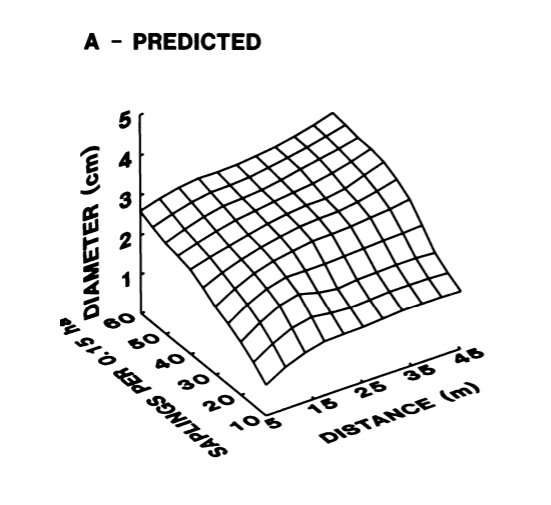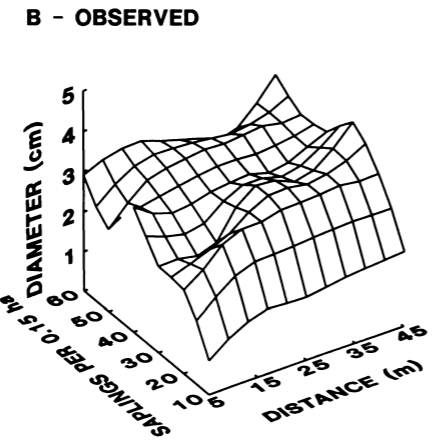Study Background
The study conducted by Fryxell and Doucet (1993) included beavers and their diet preferences when adjusted to the environment. The researchers explored the relationship between beavers’ functional response and diet choices in order to see how the beaver diet would change under the influence of the local environment. Even though beavers are herbivorous, Fryxell and Doucet (1993) mention that they also attack discrete prey similarly to non-herbivorous predators. Prior field studies and manipulative experiments were considered for the current paper in order to investigate the adaptive capabilities of beavers and monitor the alterations in diet composition. Therefore, Fryxell and Doucet (1993) suggested that dietary adjustments performed by beavers might be considered an attempt to mimic natural changes and colonize a virgin habitat. The study includes a detailed observation of how functional response in beavers affects their diet choices and the prevalence of woody vegetation.
Study Methods
Enclosures of 30x50m were used for the current study in order to investigate the feeding behaviors of beavers. Each of the enclosures included numerous mature trees and a scarce herbaceous forest floor (Fryxell & Doucet, 1993). Beavers from the same colony were used for every trial in order to remain consistent, with an overall number of 11 trials conducted and eight beavers participating in the research. There was a concrete-lined pond and a plywood lodge in each enclosure (Fryxell & Doucet, 1993). Each trial required the researchers to define a uniform spatial distribution of 65 small saplings and then place the latter to be separated from the nearest neighbors by at least 5 meters. Fryxell and Doucet (1993) observed beavers cutting saplings and carrying them to the pond before consuming them, which eventually resonates with how beavers proceed within a natural habitat. Trembling aspen, speckled alder, red maple, and mixed stands of aspen were provided to beavers during the experiment.
Fryxell and Doucet (1993) conducted seven trials with aspen saplings with little size variation and five trials with considerable alterations in size variation (2-3 cm in diameter and 0.2-5 cm in diameter, respectively). Six more trials were conducted with varied sizes and species of saplings. The study continued either until (a) 20 days had elapsed or (b) 60 out of 65 initial saplings were removed by beavers (Fryxell & Doucet, 1993). Every sapling location was correctly marked by Fryxell and Doucet (1993) in order to assess animal positions accurately. Three observers worked in four-hour shifts to monitor the activity of beavers. A map of enclosures was created in order to record the time beavers spent moving across the experiment area, cutting saplings, and carrying saplings to the lodge (Fryxell & Doucet, 1993). The functional response methodology was aligned against the technique of sequential depletion of resources. Consistent with Fryxell and Doucet (1993), every five days, the researchers would have to replace uneaten saplings to control the effects of resource palatability and density-dependent changes.
Study Results
The study conducted by Fryxell and Doucet (1993) included a predicted model and an observed model of mean sizes of aspen saplings. From Figure 1A, it is evident that both distance and density of sapling had to be affected significantly, according to the researchers’ hypotheses. The patterns of size selection that were observed by Fryxell and Doucet (1993) also remained consistent with the projected study results (Figure 1B). Closer to the end of trials, the mean size of harvested saplings was found to be positively contingent on sapling density and distance from the lodge (Fryxell & Doucet, 1993). With the aid of a multiple regression model, the researchers were able to explain the observed size variation of harvested saplings, concluding that the magnitude among sapling density and distance was similar.


Even though there was a limited amount of evidence on beavers preferring large size classes to small classes, Fryxell and Doucet (1993) were able to identify a progressively pronounced difference in size selectivity upon food item depletion. At the end of the trials, the researchers found beavers foraging unselectively for resources. It meant that the level of selectivity declined in beavers upon resource scarcity.
Study Problems and Recommendations
The core implication of the study conducted by Fryxell and Doucet (1993) was the finding that functional responses in beavers could lead to adaptive diet choices. The two potential outcomes of this challenge include questionable point stability and reduced amplitude of population fluctuations. Accordingly, beavers feeding on aspens could contribute to the idea that beaver-vegetation interactions could be predicted with the help of modeling aggregate functional response. A thorough combination of probabilities of attack and functional responses in beavers could be a predictor of specific demographic parameters as well, such as size classes, species, and spatial units (Fryxell & Doucet, 1993). Future research projects on a similar topic could affect energy gain estimations and help academics consider vital demographic parameters when deploying models of adaptive diets. Hence, behavioral tactics of beavers and other large rodents shall be predicted using the method of modeling predator-prey interactions.
Reference
Fryxell, J. M., & Doucet, C. M. (1993). Diet choice and the functional response of beavers. Ecology, 74(5), 1297-1306. Web.
Appendix A – Article for Review
Fryxell, J. M., & Doucet, C. M. (1993). Diet choice and the functional response of beavers. Ecology, 74(5), 1297-1306. Web.